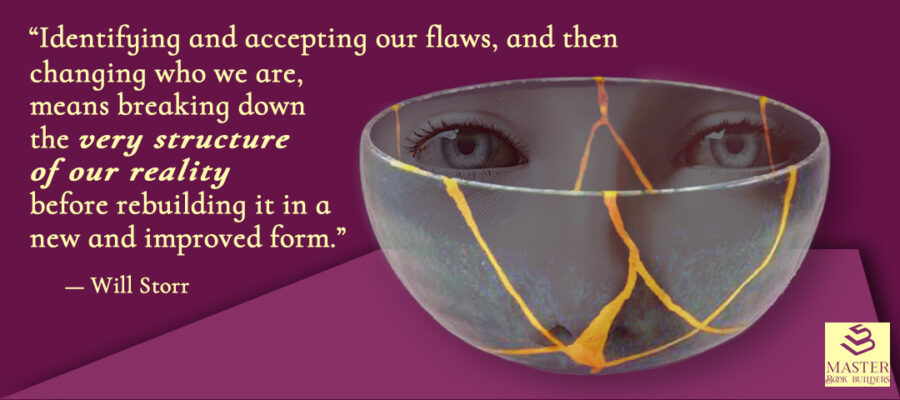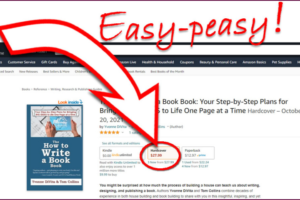Finding and Fixing Your Sacred Flaws
A funny thing happened when I was reading Will Storr’s The Science of Storytelling: Why Stories Make Us Human and How to Tell Them Better. I realized that much of his advice applied to “breaking down … [and] rebuilding … a new and improved” me, as much as it does to writing better stories about more interesting characters.
This edition of Marginalia will explore that overlap through some of the passages I scribbled notes beside along the way.
“Stories are us“
Storr begins by making his case that humans literally see and understand the world by constructing stories. We make up narratives to explain and rationalize the bits of data that our brain selects to process out of the millions coming in and mostly ignored each moment.
Ranging over evolutionary biology, psychology, neuroscience, and more, he builds a compelling case for storytelling being as natural — and as necessary — to our survival as breathing.
We’re doing it every moment of every day. You’re doing it right now, as you process the words you’re reading. The important point is that in everyday life, we’re constructing these stories as models of reality and telling them to ourselves.
Storr moves straight from there to books:
“So now we’ve discovered how reading works. … When our eyes scan over letters in a book … the brain builds a model of whatever information those letters provided. So if the words on the page describe a barn door hanging on one hinge, the reader’s brain will model a barn door hanging on one hinge. They’ll ‘see’ it in their heads.”
He echoes my own description of books from Read ‘Em & Reap. I labeled books as “social synapses” through which writers pass meaning to their readers who actively participate in reconstructing a shared meaning between them. Storr puts it this way:
“Our brain rebuilds the model world that was originally imagined by the author of the story. This is the reality of Leo Tolstoy’s brilliant assertion that ‘a real work of art destroys, in the consciousness of the receiver, the separation between himself and the artist.’ “
The powerful message for writers comes from understanding that our everyday storytelling to ourselves, building our personal model of reality, is inherently incomplete and incorrect, for at least two reasons. First, as note above, our brains only selectively process the incoming data, choosing which items to pay attention to largely based on our instinct and experience with what will keep us safe and happy.
Second, our storytelling brain casts ourselves as the hero of our story and edits what data it has allowed in ruthlessly to keep that narrative consistent.
As Storr points out, these methods for taking in and understanding the world mean our stories are told to us by a narrator — that voice in our heads — that “has no direct access to the truth.”
The lesson for writers? Neither should your characters, if you want them to ring true.
Equally important, every one of us has a different model of reality, no matter how closely they might resemble those closest to us. We all have different past experiences that create different filters in our brains for choosing both the raw material (incoming data) and the current blueprint for working that new material into the world we’re continuously remodeling.
Again, so should the characters we write and the worlds we place them in be in flux. The differing models of reality among characters initiate and propel the conflicts that drive a great plot.
And finding out how they will change themselves and their world keeps readers reading.
Oh, by the way, these insights apply fully to the stories we weave into a nonfiction book, too.
In a recent post about adopting a “scout mindset” I urged authors of both fiction and nonfiction to take a similar approach, viewing their research and writing as a way to update and correct their “maps of reality.” Helping readers do the same should be the ultimate goal of a nonfiction book, right?
Repent, Ye Sinners!
Storr identifies tribal thinking as the “original sin” of our species.
“The evil truth about humans is that we don’t just compete for status with other people inside our tribes. The tribes we belong to also compete with rival tribes.”
For fiction authors, this “evil truth” provides endless veins of conflict gold to mine. Battles to be fought. Internal struggles to be resolved. Victories to be won. As Storr reminds us, archetypal heroes selflessly defend their tribes.
“In the face of great personal peril, they kill dragons, blow up Death Stars, and rescue Jews from Nazis. They satisfy our moral outrage, and moral outrage is the ancient lifeblood of human storytelling.”
For nonfiction, understanding our original sin provides a starting point for crafting our message. Storr delivers this insight, using the example of how individuals in late adolescence adopt a favored political stance:
“. . . left or right — a tribal master-story that fits over our unconscious landscape of feelings and instincts and half-formed suspicions and makes sense of it. When this happens it can feel as if we’ve encountered revealed truth and our eyes have suddenly been opened. In fact, the opposite has happened. Tribal stories blind us. They allow us to see only half the truth, at best.”
Wait, what?!? Joining a tribe makes our map of reality less reliable?
Storr offers further evidence from the work of psychologist Jonathan Haidt:
“Take capitalism. For the left it’s exploitative. The Industrial Revolution gave evil capitalists the technology to use and abuse workers as dumb machine-parts in their factories and mines and reap all the profits. … For the right, capitalism is liberation. It freed the used and abused worker from exploitation by kings and tyrants and gave them property rights, the rule of law, and free markets, motivating them to work and create. …”
Then Storr delivers the insight and warning that nonfiction authors, especially, must heed:
“What’s insidious about these stories is that they each tell only a partial truth. Capitalism is liberating and it’s also exploitative. Like any complex system it has a trade-off of effects, some good, some bad. But thinking with tribal stories means shutting out such morally unsatisfying complexity.”
If you’re writing nonfiction to an audience within a certain tribe to help them expand, update, and correct their maps of reality, without any fundamental change, then you can use their existing tribal stories to gain credibility and provide a comfortable background for your message.
But if you’re writing to a larger audience with more than one set of tribal stories and asking them to modify their maps in more meaningful ways, your approach will be different. You’ll still need to acknowledge and respect their current stories. From there, you’ll need to use equally compelling stories, with heroes they’ll recognize and admire, to offer a new path to add to their maps.
And you’ll guide them to address their sacred flaw.
Who Do I Need to Be?
Storr provides an appendix called The Sacred Flaw Approach. It’s based on his writing course material and is aimed at guiding fiction authors through structuring a story as a five step version of the familiar Heroes Journey. It’s a wonderful tool.
But on the first page, he reveals the fact that it will apply to nonfiction, too. Indeed, that good fiction flows from real life stories.
“Life emerges from self and is a product of it. This is how story ought to work too.
“The Sacred Flaw Approach is a way of building fictional story as the brain builds a life.”
The converse follows from the same logic. Building an effective nonfiction message requires us to follow Storr’s most fundamental rule: answer what he calls “the dramatic question.”
To illustrate how Storr’s approach can be applied to nonfiction I’ll substitute the word “argument” where Storr used “plot” in the following passage:
“And so the argument moves on, in all its depth, truth, … each new development coming from character. … Throughout the argument, [readers are] gradually forced to readdress their deepest beliefs about how [your topic] works. Their previous theory of control comes under question [and] they’re compelled to repeatedly ask themselves that fundamental dramatic question: who am I? Who do I need to be in order to make this right?”
That may come across as overly dramatic, since he was writing about fiction. But you should be able to see how a compelling nonfiction book would be built the same way. By constructing your message out of a series of steps, with true stories woven through it, you reveal the “sacred flaws” in the readers’ current model of reality. You lead your audience to that same dramatic question.
Paraphrasing Storr again to direct the dramatic question at your readers:
“Finding out who [they] are, and who [they] need to become, means accepting the challenge that [your message] offers [them]. Are [they] brave enough to change?“
If your message provides them with both the reasons to change and the tools they need to overcome the challenge, then you’ve served them well and there’s a chance they will be brave enough.
Storr closes with this statement about the bravery question, with my insertion:
“This is the question a plot, [a book], and a life, asks each of us.”
With that, we close the circle to my starting point: how to build a good story and how to build a good life are not that much different.






Leave a Reply